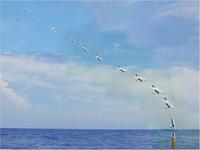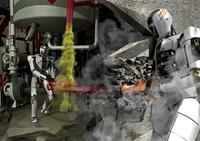-
Small, portable, fast TLC unit for explosives, drugs analysis
Field Forensics of St. Petersburg, Florida, unveiled its microTLC, a portable and easy to use solution for pre-screening and presumptive identification of drugs and explosive mixtures. Thin layer chromatography (TLC) is an established laboratory procedure which identifies compounds belonging to the same general chemical class. The microTLC makes it possible for both laboratory and field analysis to be performed by first responders and forensics scientists.
-
-
Dolphin-inspired innovative radar system to detect surveillance, explosive devices
Inspired by the way dolphins hunt by using bubble nets, scientistshave developed a new kind of radar that can detect hidden surveillance equipment and explosives.The twin inverted pulse radar (TWIPR) is able to distinguish true targets, such as certain types of electronic circuits that may be used in explosive or espionage devices, from clutter (other metallic items like pipes, drinks cans, nails for example) that may be mistaken for a genuine target by traditional radar and metal detectors.
-
-
How effective are renewable energy subsidies? It depends
Renewable energy subsidies have led to explosive growth in wind power installations across the United States, especially in the Midwest and Texas. Electricity produced by wind is emission free, so the development of wind-power may reduce aggregate pollution by offsetting production from fossil fuel generated electricity production. Emission rates of fossil fuel generators, however, vary greatly by generator (coal-fired, natural gas, nuclear, hydropower). Thus, the quantity of emissions offset by wind power will depend crucially on which generators reduce their output. In other words, the quantity of pollutants offset by wind power depends crucially on which generators reduce production when wind power comes online.
-
-
One step closer to nuclear fusion power station
Researchers have made a technological breakthrough crucial to the success of nuclear fusion reactors, allowing for clean, inexhaustible energy generation based on the workings of the stars in our galaxy. At the heart of the new development is an ingenious and robust superconducting cable system. This makes for a remarkably strong magnetic field that controls the very hot, energy-generating plasma in the reactor core, laying the foundation for nuclear fusion. The new cables are far less susceptible to heating due to a clever way of interweaving, which allows for a significant increase in the possibilities to control the plasma.
-
-
Asteroid hunter spacecraft returns first images after reactivation
In 2010 and early 2011, NASA’s Near-Earth Object Wide-field Infrared Survey Explorer (NEOWISE), a spacecraft that made the most comprehensive survey to date of asteroids and comets, discovered more than 34,000 asteroids and characterized 158,000 throughout the solar system. It was reactivated in September following thirty-one months in hibernation, to assist NASA’s efforts to identify the population of potentially hazardous near-Earth objects (NEOs).
-
-
Sandia to show Mine Rescue Robot at 2013 DARPA Robotics Challenge
Engineers from Sandia National Laboratories will demonstrate real-world robotics successes at the DARPA Robotics Challenge Trials 2013 Expo this week (20-21 December) in Florida. The challenge is focused on human-scaled robots that assist in humanitarian aid and disaster response. Sandia engineers will demonstrate the Gemini Scout Mine Rescue Robot, which was designed to overcome dangers lurking in a mining accident: poisonous gases, flooded tunnels, explosive vapors, and unstable walls and roofs. Such potentially deadly conditions and unknown obstacles can slow rescue efforts to a frustrating pace.
-
-
Shot spotting system helps Stockton, Calif. Police reduce gunfire
ShotSpotter sensors detect gunfire, then immediately transmit a signal to control center where technicians use triangulation to locate the spot of origin of the firing to within five to ten feet. The technician reports the location within thirty to forty seconds to the police to dispatch officers to the scene. Stockton, California police has been using ShotSpotter for nine months now, and the police chief says the system has helped reduce gunfire in the covered area by fifty percent.
-
-
Cybersecurity isn’t all about doom and gloom
Much is made in the press of the devastating effects that weak cybersecurity is having on the economy in the United Kingdom and globally. The threat is compounded by a significant skills shortage. The U.K. government thinks the problem is so severe that it has identified cybersecurity as a Tier 1 national security threat and invested 860 million pounds to defend the country’s digital shores. What all this means is that there is money to be made from cybersecurity and small businesses should not fear it but embrace it. The business opportunities are boundless in cybersecurity. One area that is promising in this sense is the move towards smart cities. As the infrastructure around us, such as traffic lights and utilities becomes more regularly controlled via computers, market opportunities emerge
-
-
Zapping bridges with electricity to test for corrosion
One out of nine of the nation’s bridges is structurally deficient and that more than 30 percent of bridges have exceeded their 50-year design life; the average age of the nation’s bridges is currently forty-two years. Motorists in the United States make more than 200 million trips across bridges rated structurally deficient or in need of significant maintenance and yearly inspection. Of the more than 17,000 bridges in New York, 12.5 percent are structurally deficient and 27 percent are considered functionally obsolete. One major culprit for bridges’ deterioration: corrosion of reinforcing steel. New testing method could replace expensive, time-consuming visual inspections.
-
-
New Silicon Valley focus on cybersecurity
The last time Silicon Valley focused on cybersecurity was in the 1990s. That focus saw the emergence of two giants: McAfee and Symantec. The two companies remain the most recognizable household names, thanks to their traditional firewall and anti-virus products. Now they find the arena which they thought was their own encroached from two sides. On one side there are tech giants like Hewlett-Packard and Cisco Systems, which see new revenue opportunity in cybersecurity. On the other side there is a rush of start-ups backed by large investments of venture capital.
-
-
Protecting cars from hackers
A U.S. senator has asked twenty automobile manufacturers how each plans to stave off wireless hacking attempts on the computer systems of the vehicle they manufacture, and also how they protect driver privacy. The questions by Senator Ed Markey (D-Massachusetts) indicate that he will demand that carmakers apply computer-industry security processes, including implementation of anti-virus software, incident logging, incident-response planning, software vulnerability patching, and third-party penetration testing — the last of which would stage real hacker attacks on mass-production vehicles.
-
-
Lawmakers: Old plastic gun law has not kept pace with technology
The U.S. House of Representativesvoted last Tuesday to renew the 25-year old Undetectable Firearms Actwhich prohibits firearms that can evade metal detectors and X-ray machines. Law enforcement agencies say that developments in 3D printing make the law insufficient, and lawmakers who proposed amending the Act say that the only way to make such guns detectable is to require that at least one component of the firing mechanism in a plastic gun contain enough metal to be detectable in a magnetometer — and that that component be undetachable. The NRA opposes these requirements, saying that they would infringe on the Second Amendment rights of citizens.
-
-
U.S. Navy demonstrates UAV launch from submerged submarine

The U.S. Naval Research Laboratory (NRL) demonstrated the launch of an all-electric, fuel cell-powered, unmanned aerial system (UAS) from a submerged submarine. The successful submerged launch of a remotely deployed UAS offers a pathway to providing mission critical intelligence, surveillance, and reconnaissance (ISR) capabilities to the U.S. Navy’s submarine force.
-
-
Seventeen teams to compete in DARPA Robotics Challenge Trials

Four teams that built full robot hardware and software systems using their own funds qualified to join thirteen other teams to compete in the Defense Advanced Research Projects Agency (DARPA) Robotics Challenge (DRC) Trials. The event will take place 20-21 December at the Homestead-Miami Speedway in Homestead, Florida, where spectators can observe as the robots are tested on the capabilities that would enable them to provide assistance in future natural and man-made disasters.
-
-
Standardized performance tests for emergency response robots
Seventeen teams will be directing their emergency-response robots to perform eight basic tasks which were drawn from the Fukushima Daiichi response and then converted into standardized tests by researchers at the National Institute of Standards and Technology (NIST). A year later, the capabilities of robots that qualify in this year’s trials will be tested in a more realistic disaster scenario. In the winner-take-all finals, robots will perform all eight challenges consecutively. NIST engineers have been at the forefront of using standardized performance testing for emergency response robots used in bomb-response and for urban search-and-rescue operations. Since 2005, fifteen NIST tests have been adopted as standards by ASTM International, and about forty more are under various stages of development or review.
-
More headlines
The long view
Autonomous Vehicle Technology Vulnerable to Road Object Spoofing and Vanishing Attacks
Researchers have demonstrated the potentially hazardous vulnerabilities associated with the technology called LiDAR, or Light Detection and Ranging, many autonomous vehicles use to navigate streets, roads and highways. The researchers have shown how to use lasers to fool LiDAR into “seeing” objects that are not present and missing those that are – deficiencies that can cause unwarranted and unsafe braking or collisions.
Tantalizing Method to Study Cyberdeterrence
Tantalus is unlike most war games because it is experimental instead of experiential — the immersive game differs by overlapping scientific rigor and quantitative assessment methods with the experimental sciences, and experimental war gaming provides insightful data for real-world cyberattacks.
Prototype Self-Service Screening System Unveiled
TSA and DHS S&T unveiled a prototype checkpoint technology, the self-service screening system, at Harry Reid International Airport (LAS) in Las Vegas, NV. The aim is to provide a near self-sufficient passenger screening process while enabling passengers to directly receive on-person alarm information and allow for the passenger self-resolution of those alarms.
Falling Space Debris: How High Is the Risk I'll Get Hit?
An International Space Station battery fell back to Earth and, luckily, splashed down harmlessly in the Atlantic. Should we have worried? Space debris reenters our atmosphere every week.
Testing Cutting-Edge Counter-Drone Technology
Drones have many positive applications, bad actors can use them for nefarious purposes. Two recent field demonstrations brought government, academia, and industry together to evaluate innovative counter-unmanned aircraft systems.
Strengthening the Grid’s ‘Backbone’ with Hydropower
Argonne-led studies investigate how hydropower could help add more clean energy to the grid, how it generates value as grids add more renewable energy, and how liner technology can improve hydropower efficiency.
The Tech Apocalypse Panic is Driven by AI Boosters, Military Tacticians, and Movies
From popular films like a War Games or The Terminator to a U.S. State Department-commissioned report on the security risk of weaponized AI, there has been a tremendous amount of hand wringing and nervousness about how so-called artificial intelligence might end up destroying the world. There is one easy way to avoid a lot of this and prevent a self-inflicted doomsday: don’t give computers the capability to launch devastating weapons.
The Tech Apocalypse Panic is Driven by AI Boosters, Military Tacticians, and Movies
From popular films like a War Games or The Terminator to a U.S. State Department-commissioned report on the security risk of weaponized AI, there has been a tremendous amount of hand wringing and nervousness about how so-called artificial intelligence might end up destroying the world. There is one easy way to avoid a lot of this and prevent a self-inflicted doomsday: don’t give computers the capability to launch devastating weapons.
